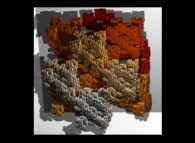
An extended Menger Sponge -iteration 5- displaying the 10.000 first digits -base 2- of the Champernowne number (=0.1 10 11 100 101 110 111 1000...) -using all base 2 integer numbers- periodically repeated in order to obtain 1.360.800 digits [Une éponge de Menger généralisée -itération 5- visualisant les 10.000 premières chiffres -base 2- du nombre de Champernowne (=0.1 10 11 100 101 110 111 1000...) -utilisant tous les nombres entiers en base 2- répétés périodiquement afin d'obtenir 1.360.800 chiffres].
Definition of the "standard" Menger sponge (related to the Cantor triadic set): A cube is cut into 3x3x3=27 identical smaller cubes.
Then the 7 central subcubes
(6 for each face and 1 at the center of the cube) are removed.
At last this process is iterated recursively with the 27-7=20 remaining subcubes.
The fractal dimension of the Menger sponge is equal to:
log(20)
--------- = 2.726833027860842...
log(3)
The "standard" Menger sponge can be defined by means of subdivision rules.
Here is the way how each of the 27 cubes of the "standard" Menger sponge at a given level is subdivided:
"standard" Menger sponge
_____________________
/ \
TTT TFT TTT
TFT FFF TFT
TTT TFT TTT
\_/
Sierpinski carpet
or again:
TTT TFT TTT TFT FFF TFT TTT TFT TTT
where 'T' ('True') and 'F' ('False') means respectively "subdivide the current cube" and "do not subdivide and destroy the current cube".
The rules are repeated at each level, but they can be changed periodically and for example:
TTT TFT TTT TFT FFF TFT TTT TFT TTT FFF FTF FFF FTF TTT FTF FFF FTF FFF
\___________________________________/ \___________________________________/
"standard" Menger sponge complement
alternates the "standard" Menger sponge and its complement.
Obviously many other rules do exist as shown below...
Beside 'F' and 'T' some other possibilities exist: 'R' that means "subdivide the current cube" or "do not subdivide and destroy the current cube" Randomly
with a given threshold between 0 and 1 (0.5 being the default value)
and 'S' that means "Stop subdividing".
Obviously 'F', 'T', 'R' and 'S' can be mixed at will...
Obviously one can use a specific rule for each cube.
The rule set "RRR RRR RRR RRR RRR RRR RRR RRR RRR" (each "R" uses the next digit -base 2- of the Champernowne number -the used colors code the reverse rank of the digits-) is used for the following pictures:

100 digits periodically repeated in order to obtain 1.539.972 digits.
| 
100 digits periodically repeated in order to obtain 520.542.072 digits.
|

1.000 digits periodically repeated in order to obtain 1.580.823 digits.
| 
1.000 digits periodically repeated in order to obtain 988.569.846 digits.
|

10.000 digits periodically repeated in order to obtain 1.360.800 digits.
| 
10.000 digits periodically repeated in order to obtain 531.370.800 digits.
|
the digits base 2 are used with the following convention:
0 --> F
1 --> T
(CMAP28 WWW site: this page was created on 08/24/2024 and last updated on 08/25/2024 11:22:29 -CEST-)
[See the generator of this picture [Voir le générateur de cette image]]
[See all related pictures (including this one) [Voir toutes les images associées (incluant celle-ci)]]
[Please visit the related DeterministicFractalGeometry picture gallery [Visitez la galerie d'images DeterministicFractalGeometry associée]]
[Go back to AVirtualMachineForExploringSpaceTimeAndBeyond [Retour à AVirtualMachineForExploringSpaceTimeAndBeyond]]
[The Y2K Bug [Le bug de l'an 2000]]
[Site Map, Help and Search [Plan du Site, Aide et Recherche]]
[Mail [Courrier]]
[About Pictures and Animations [A Propos des Images et des Animations]]
Copyright © Jean-François COLONNA, 2024-2024.
Copyright © CMAP (Centre de Mathématiques APpliquées) UMR CNRS 7641 / École polytechnique, Institut Polytechnique de Paris, 2024-2024.






